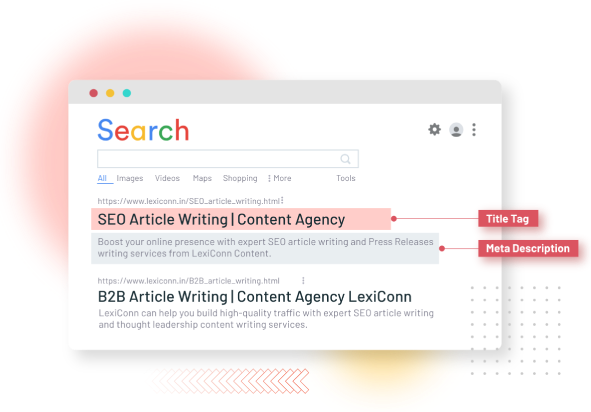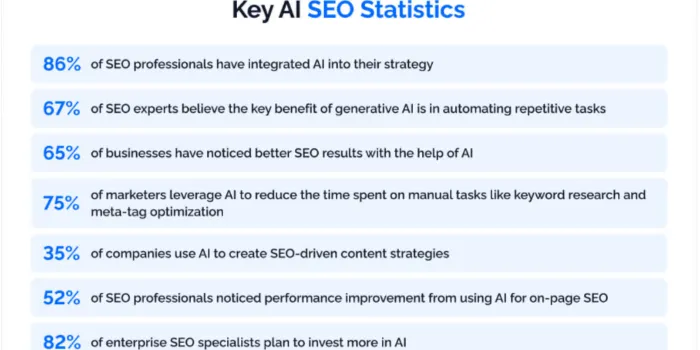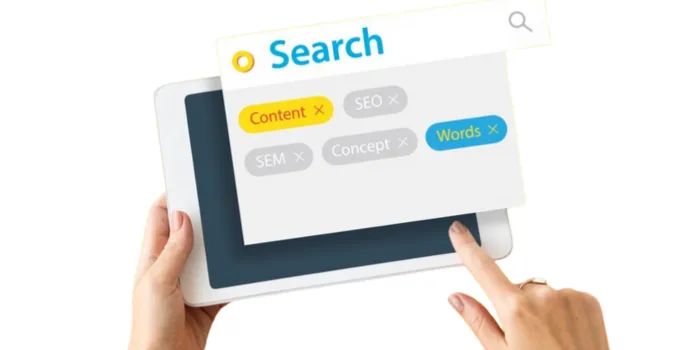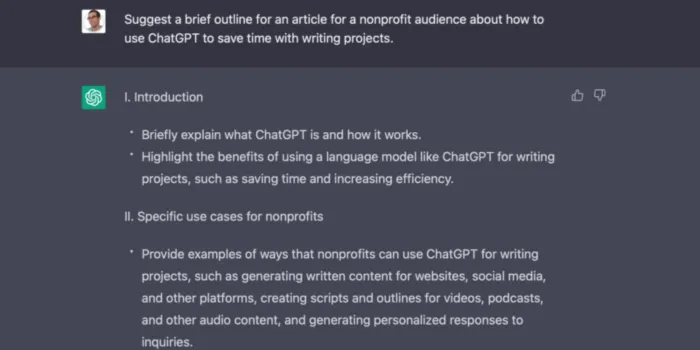

David, the owner of a small pet supply store, watched his online competitors dominate Google searches while his website barely made page five. With a limited budget and no SEO experience, he couldn't afford the monthly quotes from SEO agencies. His website traffic was declining, and his valuable pet care advice wasn't reaching local pet owners.
One evening, while researching budget-friendly SEO solutions, he discovered ChatGPT. Initially skeptical, David decided to try optimizing just one article about "choosing the right dog food for puppies." Using ChatGPT's help, he transformed his basic article into a comprehensive guide that addressed common pet owner questions. Within six weeks, his article hit the first page of Google, bringing in 50 new customers to his store.
SEO writing means creating content that people and search engines love. Think of it like writing a helpful guide that's easy to find online. ChatGPT can help you create this content by suggesting topics, generating outlines, and helping you write in a way that answers people's questions.
If you're writing about the "best coffee machines for offices," ChatGPT can help you understand what information people typically search for, like prices, features, maintenance tips, and comparisons. It's like having a research assistant who knows what your readers want to know.
In this blog, we will learn about SEO-optimized content using ChatGPT in 10 simple steps to improve your website’s ranking.

Start by identifying your main keyword - let's say "office coffee machines." Ask ChatGPT to help you generate related keywords like "commercial coffee makers," "office coffee service," or "workplace coffee solutions." Create a list of these keywords before you start writing.
Next, set up a simple process: research > outline > write > optimize > edit. ChatGPT can help with each step. For example, for the coffee machine article, first ask ChatGPT to create an outline that includes key buying factors, top brands, maintenance tips, and cost considerations.

Your headline needs to include your main keyword while being interesting to readers. Ask ChatGPT to generate multiple versions. For our coffee machine example: "10 Best Office Coffee Machines for 2024: A Buyer's Guide" or "Office Coffee Machines: How to Choose the Perfect One for Your Workplace."
Test different headline formats: numbers ("5 Best..."), how-to ("How to Choose..."), or questions ("Which Office Coffee Machine is Right for You?"). ChatGPT can help you create variations that include your keyword naturally while attracting clicks.
Let's apply this to our main keyword, "ChatGPT for SEO writing." Try variations like: "ChatGPT for SEO Writing: A Step-by-Step Guide for 2024," "How to Master ChatGPT for SEO Writing: 10 Proven Strategies," or "ChatGPT for SEO Writing: Transform Your Content in 30 Days." Notice how each version maintains the exact keyword while adding value propositions.
Use ChatGPT to analyze which headline elements perform best in your industry. For example, ask: "Generate 10 headline variations for a blog about ChatGPT for SEO writing, including time-based urgency (2024), specific benefits (boost rankings), and actionable results (step-by-step guide)." Test these different versions with your audience to see what resonates.

Meta descriptions are like mini-advertisements for your content in search results. Ask ChatGPT to write several versions that include your keyword and make people want to click. Keep them under 160 characters and focus on the value readers will get.
Example: "Discover the perfect office coffee machine for your business. Compare top brands, prices, and features. Save time and money with our expert buying guide backed by real user reviews."
Let's optimize for "ChatGPT for SEO writing". Here are power-packed meta descriptions: "Master ChatGPT for SEO writing in just one hour. Learn proven techniques to create high-ranking content that converts. Free templates and prompts included!" or "Transform your SEO content using ChatGPT. Step-by-step guide with real examples and expert tips. Perfect for beginners and pros alike."
Test different emotional triggers in your meta descriptions. For "ChatGPT for SEO writing," try: "Tired of content that doesn't rank? Learn ChatGPT for SEO writing strategies used by experts. Cut writing time in half while doubling your traffic." Or focus on FOMO: "Don't let competitors outrank you. Our ChatGPT for SEO writing guide shares insider secrets for better rankings."
Help readers visualize quick wins. Try: "Start using ChatGPT for SEO writing today. Learn our 3-step framework for creating content that ranks. Includes 10 ready-to-use prompts and real success stories." The key is balancing your keyword with compelling benefits that make readers click.

Start your content with a hook that grabs attention. Ask ChatGPT to write introductions that address a common problem. For our coffee example: "Tired of dealing with endless coffee runs and complicated machines that no one can figure out? Finding the right office coffee machine can transform your workplace."
Follow up with what readers will learn. Ask ChatGPT to outline the key benefits: "In this guide, you'll learn how to choose an office coffee machine that fits your budget, keeps your team happy, and doesn't require an engineering degree to operate."

Break your content into clear sections using H2 and H3 headers. Ask ChatGPT to create a logical structure. For the coffee machine article: "Types of Office Coffee Machines," "Key Features to Consider," "Price Comparison," "Maintenance Requirements," and "Top Recommendations."
Make each section answer a specific question readers might have. Use ChatGPT to identify common questions: "How many cups per day can it make?" "What maintenance is required?" "How much counter space is needed?" This helps both readers and search engines understand your content.

Include your keywords naturally throughout your content. Ask ChatGPT to rewrite sentences to include keywords without making them sound forced. Instead of "buy an office coffee machine," it might suggest "when choosing an office coffee machine, consider these factors."
Create variations of your keyword phrases. If your main keyword is "office coffee machines," use related terms like "workplace coffee makers," "commercial coffee systems," or "business coffee solutions" to keep the content natural and readable.

Each section should provide real value to readers. Ask ChatGPT to help you explain complex topics simply. For technical aspects of coffee machines, it might break down brewing technologies into easy-to-understand explanations without using industry jargon.
Include practical examples and scenarios. Ask ChatGPT to create comparison tables, pros and cons lists, or step-by-step guides. For coffee machines, include scenarios for different office sizes: "For a 10-person office, a single-serve machine might work best, while a 50-person office needs a commercial-grade brewer."
When using ChatGPT for SEO writing, break down complex concepts into digestible chunks. For example: "Instead of just saying 'optimize for keywords,' explain it like this: 'Think of keywords as bridges connecting your content to your readers' questions. Place them naturally in your text, like having a conversation about the topic.'"
Create scenario-based examples for different skill levels using ChatGPT for SEO writing. Beginner: "Just starting your blog? Here's a simple 5-minute keyword research process using ChatGPT." Intermediate: "Managing a small business website? Use these ChatGPT prompts to optimize your product descriptions." Advanced: "Running an agency? Scale your SEO content creation with these ChatGPT workflow templates."
Let's make it practical with clear action items. For ChatGPT for SEO writing, provide specific prompts like: "Write a meta description for [topic] that includes [keyword] and highlights [benefit]" or "Create an outline for a blog post about [topic] that targets [keyword] and answers common user questions." Follow each prompt with a real example showing the input and output.

Use ChatGPT to identify where you need to add statistics, expert quotes, or research findings. Then verify these from reliable sources. For coffee machines, you might include statistics about workplace productivity and coffee consumption, or expert opinions from facility managers.
Remember to fact-check all information ChatGPT provides. While it's great at suggesting where to add supporting evidence, always verify statistics and claims from trustworthy sources before including them in your content.

Ask ChatGPT to suggest relevant internal linking opportunities. For the coffee article, it might recommend linking to content about office break room design, workplace wellness, or office equipment maintenance guides that you've previously published.
Create a natural flow with your links. Instead of "click here," ask ChatGPT to write contextual anchor text: "Learn more about creating the perfect office break room setup" or "Check our guide on maintaining office equipment."
End your content with a clear summary and next steps. Ask ChatGPT to create a conclusion that reminds readers of the main points and encourages action: "Choose the right office coffee machine by considering your team size, budget, and maintenance needs."
Include a clear call-to-action. Ask ChatGPT to suggest different CTAs: "Ready to upgrade your office coffee experience? Download our comparison checklist" or "Need help choosing? Schedule a free consultation with our office equipment experts."
Optimizing for Featured Snippets
Structure parts of your content to target featured snippets. Ask ChatGPT to format definitions, steps, or lists in a way that Google might feature. For coffee machines, create a clear "What to Consider When Buying an Office Coffee Machine" list.
Use question-and-answer formats for key information. Ask ChatGPT to help you identify and answer common questions concisely: "How much does an office coffee machine cost?" followed by a clear, direct answer in 40-60 words.

Before publishing, have ChatGPT help you create a final SEO checklist: keyword presence in title, headers, and content; meta description optimization; image alt text suggestions; and URL structure recommendations.
Review readability and flow. Ask ChatGPT to suggest improvements for sentence structure, paragraph length, and transition words. This helps create content that's both search-engine friendly and enjoyable to read.
|
Essential On-Page Elements:
Content Structure Checks:
Technical Optimization:
Content Quality Verification:
Final User Experience Checks:
SEO-Specific Prompts to Ask ChatGPT:
|
Using ChatGPT for SEO writing can significantly improve your content creation process. Remember to combine its suggestions with your expertise and always verify information. The goal is to create content that ranks well and provides real value to your readers.
Start small with one article and gradually incorporate more ChatGPT-assisted SEO techniques as you become comfortable with the process. Monitor your content's performance and adjust your approach based on what works best for your audience and industry.
Looking to transform your content with the perfect blend of AI and human expertise? LexiConn's team of skilled writers are masters at using ChatGPT for SEO-optimized content that actually ranks. From blog posts to website copy, we, as the best content writing agency in Mumbai, help businesses like yours create content that drives results.
Visit our website or shoot an email to [email protected].



I have read and accept the Privacy Policy
Read More